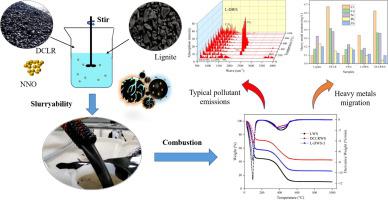Our official English website, www.x-mol.net, welcomes your
feedback! (Note: you will need to create a separate account there.)
Energy utilization of direct coal liquefaction residue via co-slurry with lignite: Slurryability, combustion characteristics, and their typical pollutant emissions
Fuel ( IF 6.7 ) Pub Date : 2022-06-27 , DOI: 10.1016/j.fuel.2022.125037 Suqian Gu , Zhiqiang Xu , Yangguang Ren , Yuxing Zhang , Yanan Tu
Fuel ( IF 6.7 ) Pub Date : 2022-06-27 , DOI: 10.1016/j.fuel.2022.125037 Suqian Gu , Zhiqiang Xu , Yangguang Ren , Yuxing Zhang , Yanan Tu

|
Direct coal liquefaction residue (DCLR) as an auxiliary feed material with lignite to prepare coal water slurry (CWS), which is then used as combustion fuels, enables recycle resources of DCLR and diminishes its impact on the surrounding environment. This paper aims to study the slurryability, combustion characteristics, and typical pollutant emissions of the lignite water slurry (LWS), DCLR water slurry (DCLRWS), and lignite-DCLR water slurry (L-DWS). Results showed that the DCLR and lignite were complementary in physicochemical properties for preparing the L-DWSs. The maximum solid concentration (ωmax ) of the DCLR was 73.19 wt% with poor static stability, whereas that of the LWS was 41.70 wt% with high pseudoplasticity. By contrast, the ωmax of the L-DWS-5 prepared from the lignite and DCLR at mass ratio of 5:5 was 53.91 wt% with lower pseudoplasticity and static stability. Meanwhile, combustion experiments confirmed that the introduced DCLR was effective in improving the ignition, burnout, and comprehensive combustion performance of the L-DWS. The Qnet, p of the slurrying samples increased from 6.70 MJ/Kg for the LWS to 14.41 MJ/Kg for the L-DWS-5. And the addition of the DCLR exhibited slight influences on the emissions of NOx and SO2 , but significantly increased HCN and other organic compounds such as Cn Hm , CO, and NH3 emissions. Furthermore, except for Pb and Zn, more than 85% Cr, Cu, and Ni were intercepted in solid residues.
中文翻译:

通过褐煤共浆对直接煤液化渣油的能源利用:浆态、燃烧特性及其典型污染物排放
直接煤液化残渣 (DCLR) 作为褐煤的辅助原料制备水煤浆 (CWS),然后用作燃烧燃料,使 DCLR 资源得到回收,并减少其对周围环境的影响。本文旨在研究褐煤水浆 (LWS)、DCLR 水浆 (DCLRWS) 和褐煤-DCLR 水浆 (L-DWS) 的浆料性、燃烧特性和典型污染物排放。结果表明,DCLR 和褐煤在制备 L-DWS 的物理化学性质上具有互补性。DCLR 的最大固体浓度 (ωmax) 为 73.19 wt%,静态稳定性差,而 LWS 的最大固体浓度 (ωmax) 为 41.70 wt%,具有高假塑性。相比之下,以褐煤和 DCLR 质量比为 5:5 制备的 L-DWS-5 的 ωmax 为 53.91 wt%,具有较低的假塑性和静态稳定性。同时,燃烧实验证实,引入的 DCLR 可有效改善 L-DWS 的点火、燃尽和综合燃烧性能。浆料样品的 Qnet, p 从 LWS 的 6.70 MJ/Kg 增加到 L-DWS-5 的 14.41 MJ/Kg。DCLR 的添加对 NOx 和 SO2 的排放影响很小,但显着增加了 HCN 和其他有机化合物(如 CnHm、CO 和 NH3)的排放。此外,除 Pb 和 Zn 外,固体残基中截获了超过 85% 的 Cr、Cu 和 Ni。
更新日期:2022-06-27
中文翻译:

通过褐煤共浆对直接煤液化渣油的能源利用:浆态、燃烧特性及其典型污染物排放
直接煤液化残渣 (DCLR) 作为褐煤的辅助原料制备水煤浆 (CWS),然后用作燃烧燃料,使 DCLR 资源得到回收,并减少其对周围环境的影响。本文旨在研究褐煤水浆 (LWS)、DCLR 水浆 (DCLRWS) 和褐煤-DCLR 水浆 (L-DWS) 的浆料性、燃烧特性和典型污染物排放。结果表明,DCLR 和褐煤在制备 L-DWS 的物理化学性质上具有互补性。DCLR 的最大固体浓度 (ωmax) 为 73.19 wt%,静态稳定性差,而 LWS 的最大固体浓度 (ωmax) 为 41.70 wt%,具有高假塑性。相比之下,以褐煤和 DCLR 质量比为 5:5 制备的 L-DWS-5 的 ωmax 为 53.91 wt%,具有较低的假塑性和静态稳定性。同时,燃烧实验证实,引入的 DCLR 可有效改善 L-DWS 的点火、燃尽和综合燃烧性能。浆料样品的 Qnet, p 从 LWS 的 6.70 MJ/Kg 增加到 L-DWS-5 的 14.41 MJ/Kg。DCLR 的添加对 NOx 和 SO2 的排放影响很小,但显着增加了 HCN 和其他有机化合物(如 CnHm、CO 和 NH3)的排放。此外,除 Pb 和 Zn 外,固体残基中截获了超过 85% 的 Cr、Cu 和 Ni。

































 京公网安备 11010802027423号
京公网安备 11010802027423号